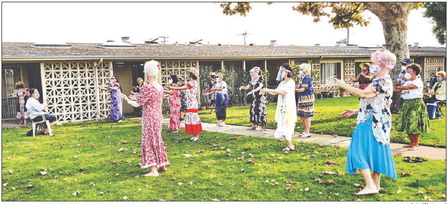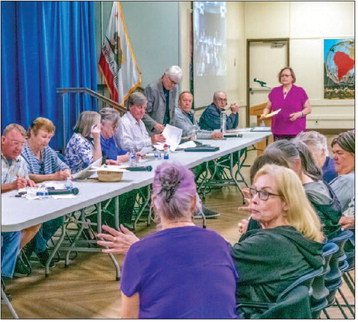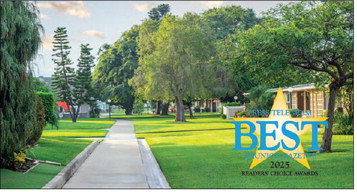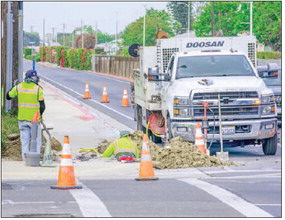There are three basic types ….
There are three basic types of courses—links, parkland and desert golf courses. What kind of golf course is the Leisure World 9-hole par 3? Peruse the definitions below and decide for yourself. The writer’s assessment is at the end.
The difference between links, desert and parkland courses is plain to see. The humps and hollows found on true links courses are generally flattened out on parkland courses, and desert courses are very flat with lots of sand and rock off the fairways. Each course is designed to be one with nature, so the course integrates with the area where it is situated. An undeserved bounce into the rough off the tee is far more unlikely when playing on the parkland or desert courses. Whereas the parkland course draws its character from the available features and makes it necessary for a player to have a game strategy, the links has a constantly changing character that challenges the player at every outing.
Links Course
The look is very natural, and golfers play to the contours of the land. There are typically few if any trees. Many links golf courses are found in coastal areas. Pebble Beach overlooks the Pacific Ocean and next to St. Andrews is the most well-known links course. The word ‘link’ or ‘links’ comes from the Old English word ‘hlinc’ meaning a ridge or a stretch of flat, undulating land along a seashore. The design incorporates this relief, which translates to undulating greens and fairways. With daily changes in weather, wind and temperatures, every round demands your full concentration.
As golf moved away from the coastline, courses became quite different.
Parkland Course
By going inland, courses became far greener and trees became a new feature. They got their name because they resembled parks. Perhaps the most famous parkland course in the world is Augusta National. Augusta is a wonderful example of the style, and golf fans can see the parkland course type at every Masters tournament. While a links course is very natural, a parkland course is one that has been heavily constructed and shaped by a course architect. A parkland course will have flat fairways compared to the rolling ones on a links. The level, well-manicured fairways make for gentle bounces and the fairways are more forgiving.
Although links and parkland golf courses are the most commonly found styles around the world, there is a third type.
Desert Courses
A desert golf course is built in an area with a natural desert. Phoenix, Palm Springs and Las Vegas are typical locations. The course is constructed among the sand dunes and natural desert features. The only green grass found on this type of course is on the tee boxes, fairways and putting greens. The rough is typically sand or other natural materials such as pine needles or scrub grasses/bushes plus lots of cacti, and rocks awaiting errant shots. There are other dangers, not found on Links or Parkland courses namely critters that can require a call to the paramedics. These courses are mostly found in the American Southwest and in the Middle East.
There are other less known course types briefly defined below:
• Heathland: Most heathland courses are found in Britain with characteristic vegetation of heather, flowering plants, and coarse grasses. These inland courses are usually a bit more open than parkland courses as their style is based on links courses. The terrain is often undulating in a similar way to links and the sandy soil is drains well, allowing for play during or after rain. • Sandbelt The sandbelt region is just outside of Melbourne, Australia, and is home to several of the world’s finest courses. The soil in this area is surprisingly sandy compared to the surrounding areas and is perfect for golf. This type will have steep sided bunkers bordering large greens.
• Stadium/Championship These courses are designed to host golf tournament, big or small. The phrase “championship” is often used to distinguish courses if a club has more than one course to choose from. But you could also define a “championship course” as a course that has hosted big tournaments, which cuts down the list dramatically. Hazeltine National Golf Club located in Chaska, Minnesota, is an example.
Stadium courses were built with spectators in mind for PGA Tour events. Stadium courses are designed for easy movement and flow of spectators and often feature strong vantage points and exciting holes. TPC Sawgrass is an example.
The LW Course
The LW Course has been explicitly created (by an architect) to fit in a specific area. Tee boxes, greens, bunkers, water hazards and fairways were sculpted rather then used as is. There a few trees defining the several individual fairways but not all. The rough is nonexistent, and the fairways are well manicured. Based on these measures and since there is no desert or ocean, the Leisure World Course is closest to parkland with some specific differences and a few unclassified characteristics.
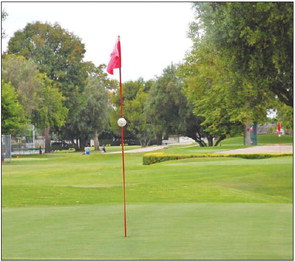
Hui O Hula meets for Hawaiian dance practice at Veterans Plaza Thursdays at 2 p.m. All LW residents are welcome.Instructor Jojo Weingart is re-introducing past favorites. The Nohili Chant is about one of the longest continuous beaches in Hawaii, called Polihale. Stretching 15 miles along Kauai Island’s west shore, Polihale represents a place of birth (or a source of life) because of its remoteness and eerie beauty. One of the verses mentions “Barking Sands Beach,” which is located in the southern part of Polihale. Barking Sands derived from the crunching sound of the sand as one walks along the beach. Dancers are learning to clap their hands as they step on their feet. Since the lockdown, this friendly community has been having outdoor social distance gatherings on the many of the green areas with shaded trees (see photo). The hula club is happy to bring dance and music, free of charge. A big mahalo/ thanks to Jody Dyer from Mutual 1, Cherry Hostler from Mutual 15 and Ana O’Brien from Mutual 10 for the invitations to entertain. Call Kaye Huff 431-2242 or email Jojo@HuiOHula. com for class information and the entertainment schedule.Jojo Weingart

